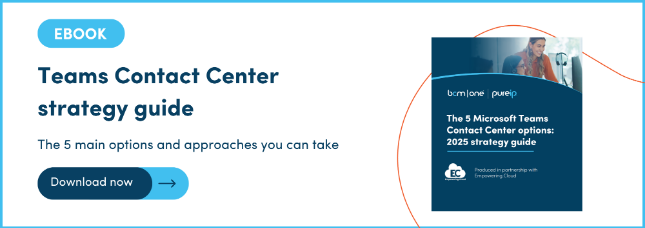You’re centralizing everything in Microsoft Teams - why stop at your contact center?
If your contact center still runs on a separate system from your Microsoft Teams environment, you're missing the opportunity to simplify operations, improve agent performance, and cut cost. This guide shows you how to bring your contact center into the Teams ecosystem and make every call, channel, and customer interaction easier to manage.
In this guide we break down the options and show you when to use each.
Option 1: Native Teams Call Queues and Auto Attendants
Good for: Small teams and simple routing requirements.
Included with Teams Phone, call queues and auto attendants help you route calls, share numbers, and track call performance. With no extra licensing required, they’re an ideal starting point for informal or internal contact centers.
- Route calls based on time of day, language, or business hours
- Share phone numbers across users with shared calling
- Track performance with historical data via Power BI
- Manage agents and queues inside Teams
Where it falls short: No advanced routing, no CRM or case management integration, and no real-time dashboards.
Option 2: Teams Premium with the Queues App
Good for: Teams already using call queues that need better visibility and management.
Teams Premium includes the Queues app, which lets supervisors and agents manage queues in real time, see active calls, and adjust participation.
- View queue status (calls waiting, service levels)
- Agents can opt in/out of queues as needed
- Supervisors can assign, reassign, or escalate calls
- Better visibility without switching platforms
When to consider it: You’re already using native call queues but need more control and live queue insight—without jumping to a full CCaaS solution.
Option 3: Certified Contact Center platforms for Teams
Good for: Mid-size or multi-channel contact centers that want deeper features.
Over 20 platforms are certified by Microsoft to integrate with Teams. These solutions use either the Connect model (external agent UI) or Extend model (agent works entirely in Teams).
- Full omnichannel: voice, chat, SMS, social, and more
- CRM integration with Dynamics, Salesforce, etc.
- Customisable IVRs and advanced routing
- Real-time dashboards and analytics
How Pure IP fits: We provide PSTN connectivity that integrates directly with all major certified platforms, with global reach and proven resilience.
Option 4: Dynamics 365 Contact Center
Good for: Enterprises with high-volume support and complex routing.
Dynamics 365 Contact Center is Microsoft's full-stack, AI-powered contact center. It's separate from Teams, but integrates natively.
- AI bots that understand customer intent
- Intelligent routing based on agent skills
- Copilot support: suggested responses and summaries
- Integrated data, ticketing, and reporting
Best fit for: Large teams that already use Dynamics or need AI-enhanced automation.
Option 5: Teams Phone extensibility
Good for: Forward-looking orgs planning for tighter integration.
The new Teams Phone extensibility model lets independent software vendors (ISVs) build native contact center apps into Teams. These apps use Azure Communication Services to deliver contact center experiences directly in the Teams interface.
- Future-ready architecture
- Full number provisioning inside Teams
- No extra software for agents
- Supports advanced AI features
Why it matters: This is where Microsoft is heading and Pure IP is already supporting it with enterprise-grade voice.
One foundation for every model: Pure IP Enterprise Voice
Every model above depends on secure, scalable PSTN connectivity. That’s where Pure IP comes in.
- Operator Connect and Direct Routing
- Voice services in hard-to-reach regions
- 24/7 expert support and proactive monitoring
- Enterprise-grade call quality and reliability
- Flexible options: BYOC, hybrid, or managed trunking
We support every contact center model that works with Teams - and help you switch between them as your needs evolve.
Quick decision guide
| Use case |
Best-fit model |
| Small internal help desk |
Native call queues |
| Teams-based call handling with real-time oversight |
Teams Premium + Queues App |
| Omnichannel + CRM integration |
Certified CCaaS platform |
| AI-powered routing, bots, Copilot |
Dynamics 365 Contact Center |
| Teams-native with advanced features |
Teams Phone extensibility |
Frequently asked questions
Does Microsoft Teams include a contact center?
Not by default. Teams Phone includes basic call queues and auto attendants. For more advanced contact center features, you’ll need Teams Premium or a certified solution.
What is the difference between Teams call queues and a full contact center?
Call queues handle basic routing and call distribution. A full contact center includes omnichannel support, CRM integration, analytics, and AI features like chatbots and intelligent routing.
What does Dynamics 365 Contact Center offer for AI?
It includes Copilot, Microsoft’s generative AI engine. Copilot can suggest agent responses, summarise conversations, generate follow-ups, and provide real-time insights.
Why do I need Pure IP?
Every Teams contact center model still needs PSTN connectivity. Pure IP provides enterprise-grade global voice services, with full support for Direct Routing, Operator Connect, and hybrid models.




